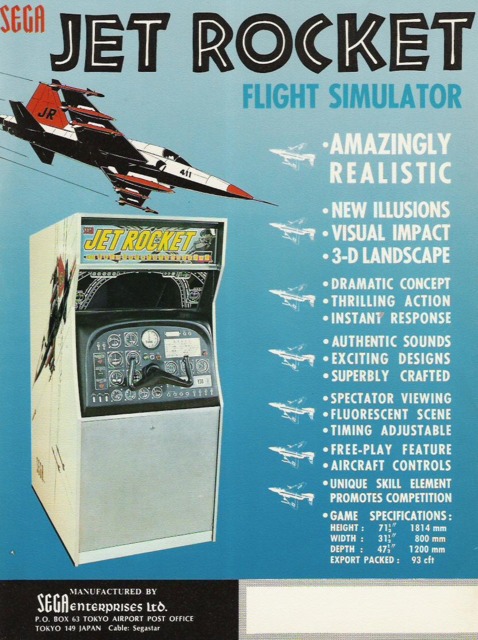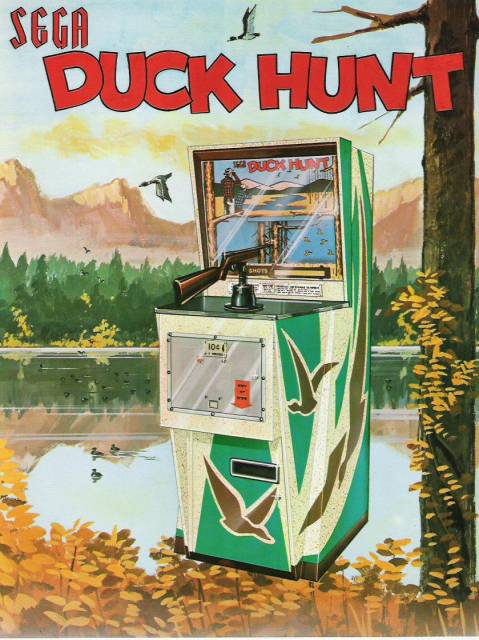Overview
The first-person perspective steps up the level of immersion in games, and allows the player to feel like they are the character. Traditionally, the use of a first-person perspective was largely limited to certain genres such as RPGs, adventure games, visual novels, driving/racing games, arcade rail shooters, and light-gun shooters.
History
 Sega's Jet Rocket (1970), the first FPS.
Sega's Jet Rocket (1970), the first FPS.The origins of a first-person perspective in gaming can be traced back to first-person shooting arcade games which predate the video game industry. An early first-person electro-mechanical arcade shooter was Periscope (1965) from Namco and Sega. Several Sega arcade games in the 1960s and 1970s resembled first-person shooting video games, but were in fact electro-mechanical games that used rear image projection in a manner similar to a zoetrope to produce moving animations on a screen. A popular example of this was Sega's first-person light gun shooter Killer Shark (1972), which was featured in the 1975 film Jaws. Sega's electro-mechanical combat flight simulator Jet Rocket (1970) featured shooting and flight movement in a 3D environment from a first-person perspective, making it the earliest first-person shooter (FPS), and an ancestor to vehicle combat FPS such as Battlezone (1980) and Hovertank 3D (1991). Nintendo's Wild Gunman (1974) also featured the use of live-action FMV footage from a first-person perspective.
While many video games featured a static, side-scrolling or top-down perspective during the 1970s and 1980s, a number of games during that time attempted to render the game world from the perspective of the player. Light gun shooters in particular often used a first-person perspective. An early first-person shooter and combat flight simulator video game was Taito's Interceptor (1975), which featured enemy aircraft that scaled in size.
Early History
 Sega's Duck Hunt (1968), the earliest first-person game.
Sega's Duck Hunt (1968), the earliest first-person game.The earliest known examples of a first-person perspective on a screen were several electro-mechanical arcade games produced by Sega which resemble first-person video games, but were in fact electro-mechanical games that used rear image projection in a manner similar to a zoetrope to produce moving animations on a screen. The first of these was the light gun shooter Duck Hunt, which Sega released in 1968. That same year, Sega released the electro-mechanical games Grand Prix, a first-person racing game projecting a forward-scrolling road on a screen, and Missile, a first-person vehicle combat sim that had a moving film strip project targets on screen and a dual-control scheme where two directional buttons move the player tank and a two-way joystick with a fire button shoots and steers missiles onto oncoming planes, which explode when hit. In 1970, the game was released in America as S.A.M.I.
In 1970, Sega released Jet Rocket, a first-person combat flight sim with cockpit controls that could move the player aircraft around a landscape displayed on screen and shoot missiles onto targets that explode when hit. Jet Rocket was the first FPS (first-person shooter) game, allowing both shooting and movement in a first-person perspective across a 3D environment. In 1972, Sega released their final electro-mechanical game Killer Shark, a first-person light gun game known for appearing in the 1975 film Jaws. In 1974, Nintendo released the arcade light gun shooter Wild Gunman, which used full-motion video projection to display live-action cowboy opponents on screen.
In 1975, Sega released the early co-operative light gun shooter video games Balloon Gun and Bullet Mark, where light guns are used to hit a variety of moving targets displayed on the monitor, with different points awarded/deducted for hitting/missing different targets. That same year, Taito released Interceptor, developed by Tomohiro Nishikado. It was an early combat flight simulator that involved controlling a jet fighter while moving a crosshair to aim and shoot at enemy aircraft that move in formations of two and scaled in size depending on their distance to the player. In 1976, Sega's Road Race extended the racing video game genre into three dimensions with a first-person perspective. It displayed a constantly changing S-shaped road with two obstacle race cars moving along the road that the player must avoid crashing while racing against the clock.
In 1980, Sega's arcade space shooter Space Tactics also allowed players to take aim using crosshairs and shoot into the screen at enemies coming towards them. A few other shooters with a first-person perspective were released during the early 1980s, such as Taito's Space Seeker (1981), Bandai's Mobile Suit Gundam: Last Shooting (1984), and several Sega releases, including the vector space simulator game Star Trek and stereoscopic 3-D game SubRoc-3D in 1982, and the laserdisc video game Astron Belt in 1983. First-person light gun shooters would rise in popularity during the mid-1980s, with Nintendo's Duck Hunt being a much-loved example.
 Z Gundam: Hot Scramble (1986) first displayed the player's weapon on screen.
Z Gundam: Hot Scramble (1986) first displayed the player's weapon on screen.In 1986, the first-person shooter Z-Gundam: Hot Scramble allowed the player to aim and lock-on to enemies while shooting and gave the illusion of six degrees of freedom in its open space levels. It was also the earliest first-person shooter to display the player's weapon on the screen, strengthening the illusion that the player is viewing the world from the perspective of the player mech.
In 1988, Golgo 13: Top Secret Episode featured various first-person shooter levels and is notable for introducing a sniper rifle, used in unique missions requiring the player to assassinate an enemy agent from a long distance using an unsteady sniper scope. In 1990, SNK released beat 'em ups with a first-person perspective: the hack & slash game Crossed Swords, and the fighting & shooting game Super Spy, which introduced the concept of showing the player's hand on-screen, strengthening the illusion that the player is viewing the world through the character's eyes. In early 1991, Data East released Silent Debuggers for the PC-Engine/TurboGrafx-16. This game featured a minimum ability to look up and down. It also allowed players to aim the gun sight when shooting at enemies.
Taito's Gun Buster was an innovative first-person shooter released in 1992 for the arcades. It featured on-foot gameplay and a unique control scheme where the player moves using an eight-direction joystick and takes aim using a mounted positional light gun. It was also unique in allowing two-player cooperative gameplay for the mission mode, and featured an early deathmatch mode, where either two players could compete against each other or up to four players could compete in a team deathmatch, consisting of two teams with two players each competing against each other.
Mainstream FPS
 Shooting Nazis in Wolfenstein 3D (1992).
Shooting Nazis in Wolfenstein 3D (1992).First-person shooter gameplay had its first steps into the mainstream with id Software's Wolfenstein 3D (1992). Later it was used in the classic game, Doom (1993), which made great strides in first-person shooter gameplay and, along with Quake (1996), cemented first-person shooters as a staple of PC gaming.
3D Gaming
 Technosoft's Plazma Line (1984), the first 3D polygon first-person video game.
Technosoft's Plazma Line (1984), the first 3D polygon first-person video game.In 1980, Sega's arcade space shoot 'em up Space Tactics allowed players to take aim using crosshairs and fire lasers into the screen at enemies coming towards them, creating an early 3-D effect. In 1982, Sega's SubRoc-3D also featured a first-person perspective and introduced the use of stereoscopic 3-D through a special eyepiece. In 1984, Technosoft released Plazma Line, a first-person space racing game. Released for the FM-7 computer, it is considered the first computer game with 3D polygon graphics. In 1988, Arsys Software's Star Cruiser, an early first-person shooter, was an innovative game that introduced the use of fully 3D polygon graphics as well as action RPG elements. The backgrounds, objects and characters in the game were rendered in 3D polygons, many years before 3D polygons became widespread in the gaming industry. It was released for the NEC PC-8801 computer in 1988, and was ported to the Sharp X68000 computer in 1989 and the Sega Mega Drive/Genesis console in 1990.
In 1994, Sega AM2's Virtua Cop popularized the use of 3D polygons in first-person perspective shooter games. That same year, Exact released the Sharp X68000 computer game Geograph Seal, a fully 3D polygon first-person shooter, notable for its unique blend of free-roaming shooting and platform game mechanics. The following year, Exact released its successor for the Sony PlayStation console, Jumping Flash, which was similar but placed more emphasis on the platforming rather than the shooting.
In 1994, From Software released King's Field for the PlayStation. This title seems to predate nearly all other fully polygon, free-roaming, real-time, first-person action games. It contains RPG elements and a mix of close and long range combat game play.
In 1997, Rareware and Nintendo released GoldenEye for the N64. Combining first-person shooter elements from Doom with arcade light-gun shooter elements from Virtua Cop, GoldenEye is commonly credited with making the first-person shooter a viable genre on a console system. Since GoldenEye, first-person shooters have become very popular on consoles, and more games in other genres have utilized the first-person view to a greater extent, such as adventure games, RPGs, and any game where the developer feels more immersion is needed.
 First-person mode in Mario Kart 7, in which the player sees the track up close.
First-person mode in Mario Kart 7, in which the player sees the track up close.In the modern era, not many advancements can be made to the core mechanics of first-person control, so the focus seems to have shifted to immersion. Games like the Metroid Prime series contain effects where if the lighting is just right, the player can see the reflection of Samus Aran's face on the inside of the visor. Also, in the Halo series, the HUD is designed to always look like the player is viewing the info inside a helmet, and then when perspective switches to third-person, the HUD changes as well. The Nintendo 3DS game Mario Kart 7 introduced first-person mode for the first time in the Mario Kart franchise where players can see the track up close, giving them a great view of the scenery during the race. Sometimes, the F1 series used this concept to see it all unfold during these GP races.
Log in to comment